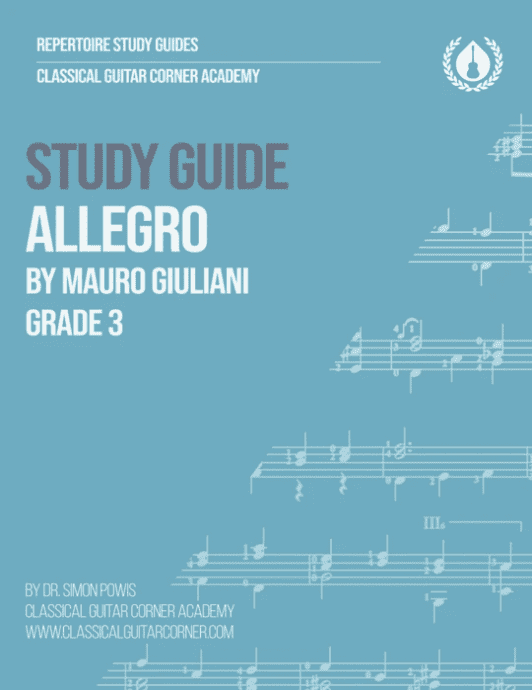Giuliani Allegro Lesson (Op.50, No.13)
In this article we’ll look at Allegro by Giuliani. This piece comes from Giuliani’s Le Papillon, Op.50. Below you’ll find a Study Guide so you can follow along with the lesson, a full video lesson on the piece, and a performance video.
Giuliani Allegro Study Guide
Before we get started, be sure to download a free PDF of the study guide for this piece.
The Study Guide for Mauro Giuliani‘s Allegro contains all of the examples and exercises to go along with the video. Starting with the full score, it provides a series of exercises and practice aids to help you learn the piece. It is just like having a one on one lesson!
Download the Study Guide
Giuliani Allegro Lesson
This is an exciting piece because it is moto perpetuo, with perpetual sixteenth-note motion throughout. But it also has a harmonic rhythm that gets more intense as the piece progresses.
Key of A Harmonic minor
Another interesting feature of this piece is the use of the A Harmonic minor scale. While normally A minor has no sharps or flats (like C Major), A Harmonic minor has a G#. Along with this more exotic sounding scale, the chords stay relatively simple, making for predictable progressions.
Bass Voice
The bass voice takes the form of something like a melody. It provides a lot of movement and draws our attention. Because it’s melody-like you can play with the bass line to make it more expressive. We might use dynamics and color to add some musical expression to this voice.
One thing that really helps make the bass voice more exciting is to use bass stopping. Bass stopping provides a much cleaner texture to the line. It also provides a punchier rhythm in the bass for some nice counterpoint with the arpeggios above.
Arpeggios
When we add the bass voice to the rest of the music we end up with a simple pimiaimi arpeggio in the right hand. Most important here is that you have a steady pulse with even sixteenth notes.
Left-hand Fingering
Pay attention to places where you have pivot fingers. These are places where one finger will stay in the same place as you “pivot” from one chord to another. Be sure to pay close attention to these as they make the transitions easier. I’ve highlighted two of those places in the study guide.
Dropped Notes
Be sure not to drop notes at the end of arpeggios where you have quick shifts in the left hand. One way to avoid that is to intentionally accent the danger notes so that you’re not dropping them. After you’ve done that a few times, go back to playing the transitions normally. Make sure to continue focusing on not dropping notes.
Dynamics and Articulation
Musicality is something you should be focusing on right from the beginning. But sometimes we’re just focused on getting the notes right. So I’ve provided some musical examples for you to focus on as you’re learning the notes. Try them out and also come up with choices of your own.
Giuliani Allegro Performance Video
***
This lesson is one of many repertoire pieces at Classical Guitar Corner Academy. Each lesson has a full video lesson with closeups of both hands, PDF download of the sheet music, accompanying worksheets and exercises, performance videos, and more. Join Classical Guitar Corner Academy today!

